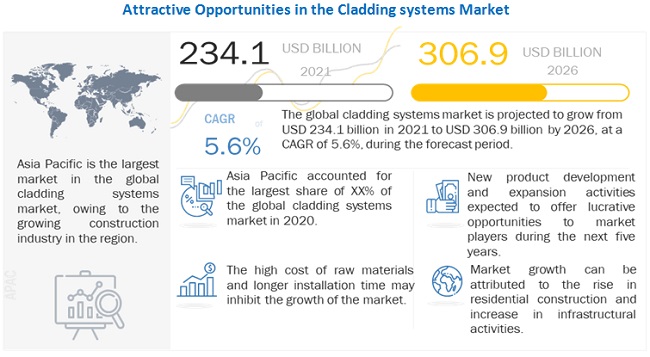
The cladding systems market is projected to grow from USD 234.1 billion in 2021 to USD 306.9 billion by 2026, at a CAGR of 5.6% from 2021 to 2026. Cladding systems market is expected to grow in accordance to the growth of construction industry across the globe. Factors such as increase in the residential and commercial construction and infrastructure activities, along with the demand for durability of cladding systems with the ability to withstand various weathering actions and resist chemical attacks & deterioration are expected to support market growth during the forecast period.
To know about the assumptions considered for the study download the pdf brochure
In terms of volume, the ceramic segment is estimated to lead the cladding systems market.
Ceramic is mainly used for tile cladding, hence play an important role in the construction industry. The ceramic tiles enhance the overall atmosphere of a residential or commercial landscape. The selection of the type of these tiles is based on several factors such as ease of maintenance, durability, comfort, safety, style, and design templates. Foot traffic plays an important role in the selection of the type of ceramic tiles. The wall tiles are employed in the interior as well as the exterior of the building to meet the requirement of decoration or aesthetics. The usage of ceramic tiles ranges from bathrooms and kitchens in households to laboratories, restaurants, medical centers, shopping centers, schools, and government buildings.
In terms of both value and volume, the wall cladding segment is projected to grow at the highest CAGR from 2021 to 2026.
Wall claddings are designed to protect the exterior wall from the effects of weathering and also to enhance the appearance of the walls in a building. Brick, stucco, and EIFS wall cladding trends have declined over the years due to their increasing price, whereas wood and fiber cement wall cladding are gaining momentum, especially in residential buildings. In commercial buildings such as warehouses and manufacturing plants, concrete and metal form the main wall cladding systems. Concrete cladding such as slabs and precast panels are widely used in industrial applications. Metal cladding, such as steel, is also used in other industrial buildings such as cool stores and freezing units.
The residential segment is estimated to grow at the highest CAGR during the forecast period, in terms of both value and volume.
Demand for cladding in the residential segment is primarily attributed to the aesthetic appeal, along with properties such as durability and protection from extreme weather. Other benefits such as fire protection and high thermal efficiency will further drive the demand for cladding systems. Most favorable materials for residential cladding systems include fiber cement, vinyl, bricks, and timber wood. The spending in residential construction is estimated to witness a surge, particularly in the emerging Asia Pacific and South American regions; there is a trend of urbanization observed in these regions, resulting in a higher growth rate for the residential construction market, as compared to developed markets.
Asia Pacific region is projected to account for the largest share in the cladding systems market
The Asia Pacific region is projected to lead the cladding systems market, in terms of both, value and volume, from 2021 to 2026. Factors such as increasing availability of raw materials and manpower, along with sophisticated technologies and innovations have driven the cladding systems market growth in the Asia Pacific region. In addition, growing construction sector, particularly in rapidly-growing countries such as China and India and huge foreign investments drives the Asia Pacific cladding market. However, consumers in this region are price-conscious and lay a lot of importance on this criterion in every aspect of their purchase. Manufacturing cost-effective cladding systems is a challenge faced by players operating in this region.
Compagnie de Saint-Gobain S.A. (France), DowDuPont (US), Tata Steel Limited (India), Arconic (US), Westlake Chemicals (US), Etex Group (Belgium), James Hardie Industries PLC (Ireland), CSR Limited (Australia), Nichiha Corporation (Japan), Boral Limited (Australia), Cembrit Holding A/S (Denmark), Louisiana Pacific Corporation (US), and Kingspan PLC (UK) are key players operating in the cladding systems market. Expansions, acquisitions, investments, and new product developments are some of the major strategies adopted by these key players to enhance their position in the cladding systems market.
Read More: https://www.marketsandmarkets.com/ResearchInsight/cladding-system-market.asp


